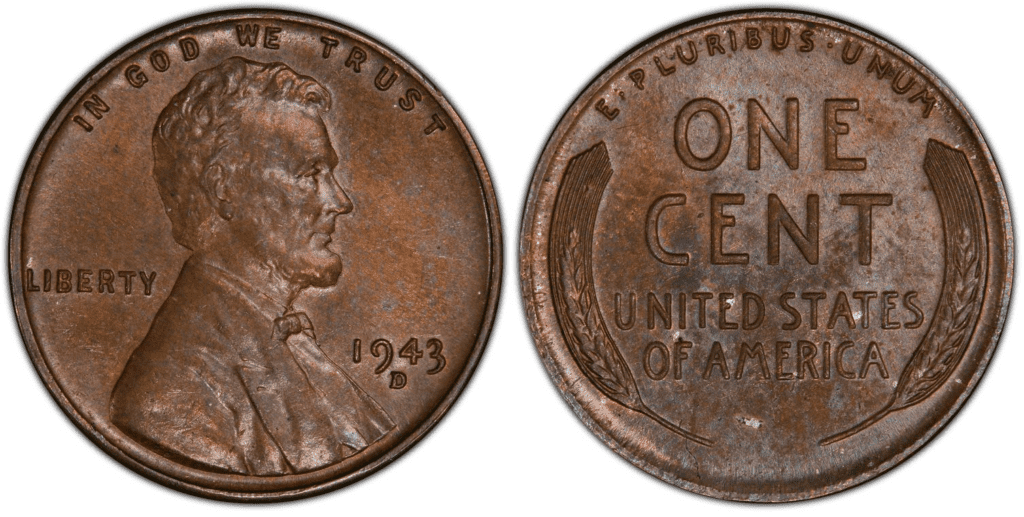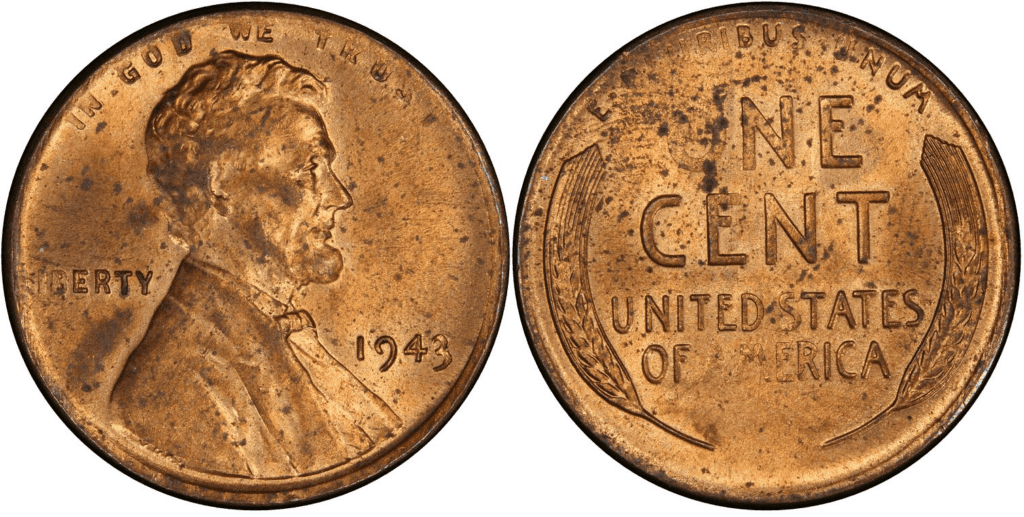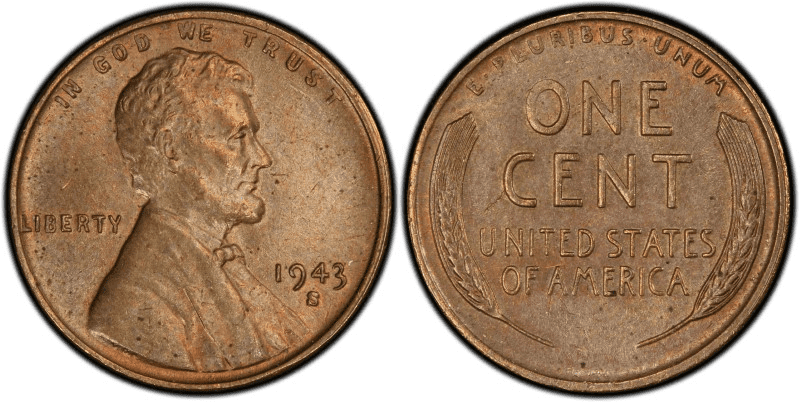What Is the 1943 Lincoln Copper Penny Made Of?
The 1943 copper Lincoln penny is among the most interesting years for the popular 1-cent coin. As you may remember, the United States was in the middle of the second World War, and this affected how the Lincoln penny and the rest of the US coins were manufactured.
Here’s an interesting fact you need to consider: the 1943 Lincoln penny was primarily made of zinc-coated steel, not copper. However, according to some estimates, there are currently about 10 to 40 1943 Lincoln pennies that were discovered to be made of copper.
The 1943 Lincoln copper penny is made of 95% copper and 5% tin and Zinc. The weight is 3.11 grams, and the diameter is 19 millimeters. Because of its extreme rarity, the 1943 Lincoln copper penny is super expensive and valuable.
For the design, it is essentially the same as other Lincoln pennies. It features Abraham Lincoln on the obverse. Inscriptions include the following:
- IN GOD WE TRUST
- LIBERTY
- 1943
- Mint mark
On the reverse side of the coin, you’ll find two stalks of wheat, which gives it the nickname “Wheat penny.” The inscriptions include:
- E PLURIBUS UNUM
- ONE CENT
- UNITED STATES OF AMERICA
You might wonder, “Why did the US Mint change the composition of the Lincoln penny in 1943?”
The answer is that the United States needed copper because it was an important raw material in making weapons, particularly bullets, for the war. At that time, the US Congress instructed the US Mint to change the composition of the US coins. The US Government needed as much copper as possible.
Since the penny was made of 95% copper, it was the primary coin affected by the new law. In 1943, the Lincoln penny transitioned from bronze to steel.
Nevertheless, there were still some 1943 pennies that were struck on a bronze planchet. According to some theories, this happened because some blank cupronickel planchets remained in the press hopper. So, when the production of the steel penny had started, the cupronickel planchets were accidentally added to the circulation.
1943 Lincoln Copper Penny Varieties
There were only less than 50 1943 copper pennies today. Nevertheless, these pennies were struck in the three mint centers, giving rise to three varieties.
Moreover, the 1943 copper pennies struck in Philadelphia have three subtypes determined based on color. The subtypes are Brown, Red and Brown, and Red. Generally speaking, the redder the coin’s color, the more valuable they are.
The three types of the 1943 Lincoln copper penny are 1943-D, 1943-P, and 1943-S copper pennies. Here’s a deeper look at each of them:
1943 D Copper Lincoln Copper Penny
Edge: Plain
Mint Mark: D
Place of minting: Denver
Year of minting: 1943
Face Value: $0.01 (one cent)
Price: $212,750 to $840,000
Quantity produced: Unknown
Designer: Victor David Brenner
Composition: 95% Copper and 5% Tin and Zinc
Mass: 3.11 grams
Diameter: 19.00 mm
Thickness: 1.75 millimeters

At the time of this writing, there’s only one 1943-D copper penny known to have existed. Not only that, but the 1943-P copper is the best example of the 1943 copper penny varieties.
The story behind this particular coin is interesting. According to coin historians John Wexler and Kevin Flynn, the coin was first owned by a former employee working in the Denver Mint. It was believed that he deliberately struck the copper planchet with the 1943 penny die. He even struck the coin twice to make it as detailed as possible.
The existence of the copper coin was kept secret until this employee died. The coin was then given to one of his children. In 1996, this person then auctioned the coin to Superior Galleries. Before it was auctioned, the coin was first assessed by ANACS, and it was declared to be a genuine coin.
Afterward, the coin was then sent to NGC to be graded. It achieved a grade of MS64BN. PCGS also gave the same grade.
There’s also a different version of the story. According to Dr. Sol Taylor, John R. Sinnock, the former Chief Engraver of the US Mint, struck the bronze 1943 penny.
No matter how the 1943-D copper originated, it is undoubtedly one of the most sought-after and expensive pennies.
1943 P Copper Washington Quarter
Edge: Plain
Mint Mark: none
Place of minting: Philadelphia
Year of minting: 1943
Face Value: $0.01 (one cent)
Price: $186,000 to $372,000
Quantity produced: Unknown
Designer: Victor David Brenner
Composition: 95% Copper and 5% Tin and Zinc
Mass: 3.11 grams
Diameter: 19.00 mm
Thickness: 1.75 millimeters

The Philadelphia Mint also produced a few of the 1943 copper pennies. Although the exact number is unknown. The 1943-P copper penny comes in three types: Brown, Red-Brown, and Red.
The price is just astronomical. Can you imagine how a coin with a face value of 1 cent will be sold for around $186,000 to $372,000? That’s amazing.
Of course, because of the extreme rarity of this 1943 copper, some people have thought it could be worth a million dollars. Nevertheless, no record shows that a penny was sold for this amount.
The 1943-P penny took the world of coin collectors by storm. So, it’s no wonder that a few people tried and are trying to create fake 1943-P copper pennies. To be sure, you can use a magnet. If the penny sticks to the magnet, it is not a real copper coin.
1943 S Washington Quarter
Edge: Plain
Mint Mark: S
Place of minting: San Francisco
Year of minting: 1943
Face Value: $0.01 (one cent)
Price: $141,000 to $504,000
Quantity produced: 5
Designer: Victor David Brenner
Composition: 95% Copper and 5% Tin and Zinc
Mass: 3.11 grams
Diameter: 19.00 mm

At the time of this writing, there were only 5 1943-S copper coins that have been discovered. Despite the intense and persistent search for this rare coin, only a few showed up. It was in 1944 that the first 1943-S copper appeared. A 14-year-old collector discovered it.
List of 1943 Lincoln copper Penny Errors
The 1943 copper penny is itself an error coin. It was a type of planchet error. All 1943 Lincoln pennies were supposed to be made of steel. Yet, a few 1943 1-cent coins were made of copper.
How Much Is The 1943 Lincoln Copper Penny Worth Today?
The 1943 Lincoln copper penny has a face value of one cent. Its melt value isn’t too much, which can be just less than $1.
Nevertheless, the true value of the 1943 Lincoln copper penny lies in its numismatic value. Take a look at this chart to help you better understand its price:
| Coin | Condition | Grade | Mintage | Value |
| 1943 D Lincoln Penny | Choice Uncirculated – Brown | MS 64 | 1 | $212,750 to $840,000 |
| 1943 P Lincoln Penny | Extremely Fine – Brown | XF 45 | Unknown | $186,000 to $193,875 |
| 1943 P Lincoln Penny | About Uncirculated – Brown | AU 50 to AU 58 | Unknown | $204,000 to $336,000 |
| 1943 P Lincoln Penny | Uncirculated – Brown | MS-60 to MS-62 | Unknown | $97,750 to $372,000
|
| 1943 P Lincoln Penny | Extremely Fine – Brown | XF 45 | Unknown | $186,000 to $193,875 |
| 1943 P Lincoln Penny | About Uncirculated – Brown | AU 50 to AU 58 | Unknown | $204,000 to $336,000 |
| 1943 P Lincoln Penny | Uncirculated – Brown | MS 60 to MS 62 | Unknown | $97,750 to $372,000
|
| 1943 S Lincoln Penny | Very Fine – Brown | VF 35 | Unknown | $141,000 to $207,000 |
| 1943 S Lincoln Penny | About Uncirculated | AU 53 to AU 55 | Unknown | $211,500 to $282,000 |
| 1943 S Lincoln Penny | Select Uncirculated | MS-63 | Unknown | $504,000 |
How Does The Grading System Work?
The Sheldon Scale is used by numismatists to provide a numerical value to coins. The Sheldon Scale goes from poor (P-1) to perfect mint state (P-1) (MS-70). Coins were originally evaluated using words to reflect their condition (Good, Fair, Excellent, Etc.). Unfortunately, coin collectors and dealers had different ideas about what each of these terms represent.
Professional numismatists joined together in the 1970s and established CoinGrading standards. These numismatists now assign grades at key places on the seventy-point scale, using the most regularly utilized numeric points in conjunction with the original adjective grade. The following are the most common coin grades:
-
-
- (P-1) Poor – Indistinguishable and probably damaged; if used, must have a date and mintmark; otherwise, rather battered.
- (FR-2) Fair – Nearly smooth, but without the damage that a coin graded Poor often possesses. The coin must have enough detail to be identified.
- (G-4) Fair – Inscriptions have merged into the rims in some areas, and important elements have been mostly erased.
- (VG-8) Very Good- A little weathered, but all of the primary design elements are visible, albeit faintly. There is little if any, central detail left.
- (F-12) Good – The item is very worn, yet the wear is even, and the overall design details stand out clearly. Rims are almost completely isolated from the field.
- (VF-20) Very Fine – Moderately weathered, with some finer features still visible. The motto or all letters of LIBERTY are readable. Both sides of the coin have entire rims that are separated from the field.
- (EF-40) Extremely Fine – Gently used; all gadgets are visible, and the most important ones are bold. The finer details are bold and clear, however, light wear may be seen.
- (AU-50) Uncirculated – Slight evidence of wear on the coin’s design’s high points; may have contact marks; eye appeal should be adequate.
- (AU-58) Uncirculated Choice – Slight traces of wear, no severe contact marks, almost full mint shine, and great eye appeal.
- (MS-60) Mint State Basal – Strictly uncirculated; no indication of wear on the coin’s highest points, but an unsightly coin with reduced luster, visible contact marks, hairlines, and other flaws.
- (MS-63) Mint State Acceptable – Uncirculated, but with contact scratches and nicks, little reduced shine, but otherwise appealing appearance. The strike is weak to average.
- (MS-65) Mint State Choice – Uncirculated with great mint shine, very little contact blemishes, and exceptional eye appeal. The strike is unusually severe.
- (MS-68) Mint State Premium Quality – Uncirculated with superb luster, no obvious contact marks to the naked eye, and exceptional eye appeal. The strike is quick and appealing.
- (MS-69) Almost Perfect Mint State – Uncirculated with perfect brilliance, a sharp and appealing strike, and extremely good eye appeal. A near-perfect coin with minor imperfections in the planchet, strike, and contact markings (seen only under 8x magnification).
- (MS-70) Mint State Perfect – Under 8x magnification, there are no tiny imperfections discernible; the strike is crisp, and the coin is perfectly centered on a beautiful planchet. Rarely seen on a coin, this coin is bright and whole, with original luster and exceptional eye appeal.
-
Are There Any Rare 1943 Lincoln Copper Penny?
All 1943 Lincoln copper pennies are rare. However, the rarest of them all is the 1943-D variety up to this day since only one example was found.
Where To Buy Or Sell 1943 Lincoln Copper Penny?
Since the 1943 Lincoln copper penny is rare, a simple Google search might not yield many results. While yes, you can easily find Lincoln copper pennies struck in 1943 on the Internet, you need to be extra careful because many fake 1943 copper pennies are out there.
Moreover, if you want to be sure, visit the website of coin grading service providers such as ANACS, ICG, PCGS, and NGC. These reputable companies regularly grade coins; if they have graded a genuine 1943 copper penny, they would have a record. They would know whether it is for sale or not as well. They can also tell you how to buy a 1943 Lincoln copper penny.
If you have a 1943 Lincoln copper penny and want to sell it, you can contact auction houses such as Heritage Auctions, Bowers & Merena, and Legend Rare Coin Auctions, to name a few. They can help you sell your coin at an even higher price. Of course, you can sell your coin on eBay or Amazon, but the price might not be that high.
FAQs
How much should a 1943 copper penny weigh?
A 1943 copper penny weighs 3.11 grams. It is slightly heavier than the 1943 steel penny, which is 2.70 grams. Pennies struck from 1982 to the present weigh 2.5 grams.
How can you tell if a 1943 copper penny is real?
You can do a magnet test. A genuine 1943 copper penny shouldn’t stick to the magnet. If it sticks to the magnet, then it is more likely to be made of steel.
What are the odds of finding a 1943 copper penny?
According to some estimates, the odds of you finding one 1943 copper penny is about one in 15 million, considering there are about 200 million standard-struck pennies.
